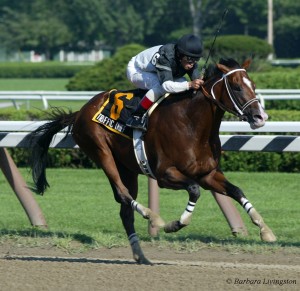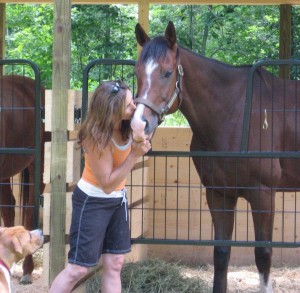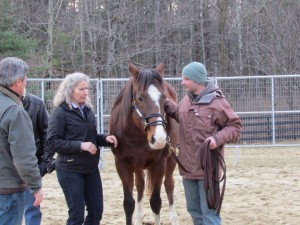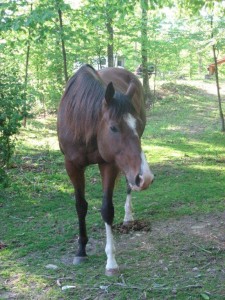Out on the Saratoga turf track, Valerie Buck piloted a recalcitrant racehorse to turn and face the onslaught of careening Thoroughbreds and jockeys zooming toward them.
In a desperate bid to reignite Traffic Chief’s interest in racing, she had struggled to switch up his training, hoping she could motivate the once-successful runner to move out one more time.
But instead of running, the tired animal with sore feet did the only thing he could. He stopped.
“We were all in danger when he did that. There were so many horses out there that day, buzzing past us at the gallop, or just finishing up a breeze,” Buck says. “When I saw an outrider coming toward us” to help “I hopped off his back before we could cause a collision with another horse.”
Walking back to the shedrow in August 2005, Buck felt her heart swell for the big animal who ambled beside her. She knew him to be a good horse, and in his heyday, Traffic Chief was among the best. He had amassed nearly $300,000 in winnings crossing the finish line first, and counted among his victories The Albany at Saratoga, years before.
Race name: Traffic Chief
Sire: Colonial Affair
Dam: Miss Forte
Foal date: 2001, Stonewall FarmTo her, Chief was just an old soldier who was misunderstood.
“Beneath his hard-to-handle disposition, I knew there was a sound-minded horse inside,” she says.
Shortly after the frightening refusal on the track, and following a miserable finish to his last race at Finer Lakes, Buck did the only thing she could. She adopted him.
After gelding surgery, she turned him out in her backyard in Saratoga, and watched as he struggled to transition from track life to a civilian pace.
And like any soldier who has spent a lifetime on the go, following orders, and succeeding in a super-charged environment, the return to everyday life was hard for Traffic Chief.
“He was a little depressed at first, and he didn’t know how to be with other horses,” she says. “A lot of racehorses are taken away from their mothers at a young age and have had limited time socializing with other horses. In a way, it’s like they don’t know how to speak their own language.”
Over the years, Buck helped Traffic Chief cope with his new, quieter life. She coaxed him into the herd, where at first shy and aloof, he grew to be a gregarious leader—never rude.
At the same time, she forged a strong bond between herself and her warhorse, employing all the skills she’d gained as an exercise rider, and those acquired as a recent convert to natural horsemanship techniques.
Then, in 2009, a career-ending accident forced her to conclude her track career. But while she healed from injuries suffered in the fall that crushed a vertebra in her neck, Buck grew even closer to Traffic Chief.
She was about as burned out from riding racehorses as Traffic Chief had been from racing on the day he stopped on the Saratoga Racetrack at this point.
But her love and appreciation for her horses never waned. Whether she was laughing at Chief’s goofy antics—a propensity to grab the very tool she reached for while doing chores, a hammer being a favorite—or being quiet together, she knew her warhorse had a healing touch.
So, in November 2011, when an innovative program uniting Thoroughbreds with war veterans opened its doors near her Saratoga home, Buck reached out to highly decorated Vietnam veteran Bob Nevins, the founder of the Saratoga War Horse Project.
His idea was to aid returning soldiers suffering from everything from being out of step with life, to a variety of physical and emotional battle scars, by pairing them with ex-racehorse Thoroughbreds.
“In a way, retiring racehorses and veterans lead a parallel life. They’ve both been changed by their service, either to the military, or to racing,” and by connecting the two, they may forge a mutual understanding, which is healing.
Maj. Judith Maloney, Chief of Plans, 109th Airlift Wing, was among the first soldiers to be introduced to Traffic Chief.
The veteran of Operations Just Cause, Desert Shield and Desert Storm, felt her self-protective shell melt a little on the November day she and Chief connected in the pen.
“It felt like we were two warriors who are starting to soften up,” she says. “I realized in the round pen that he was touching me with his big, open heart.”
The mechanics of the connection are simple enough: the horse is turned loose to run within an enclosed pen, while the soldier stands in the middle. When the horse appears “softer” and ready to connect, the soldier turns his or her back on the horse, and quietly, gently, the horse approaches and touches his muzzle to the soldier’s right shoulder.
The emotional tug of that moment of connection, however, is harder to describe, Maloney admits.
“It’s just an amazing experience when such a large, powerful animal, who could hurt you if they wanted, comes up and connects with you instead,” she says. “When he came off the line of the pen and put his face on my right shoulder it was like complete acceptance — it was peaceful.”
Before connecting with Traffic Chief, Maloney did not realized how emotionally closed off she had become. Twenty-three years spent in military service had its amazing rewards. But, serving as a medical technician and logistics officer was often stressful.
In a sense, working in the military is comparable to the work a racehorse does, she says.
“The Thoroughbred racehorse is on point and moving all the time. It’s a lot like us,” Maloney says. “You have to be tough, do your job, and be moving all the time.
“When your service ends, the question becomes, how do you settle down? How do you not remain so on point all the time?”
In the round pen with Traffic Chief, Maloney started to feel how good it is to stop, take a deep breath, and allow a magnificent force of nature to stand near.
The experience with the Saratoga War Horse project has made Maloney and Buck great believers in the powerful healing capacity of horses.
“We see the veterans with the amputated legs, but you don’t see the invisible wounds,” Buck says. “Thoroughbreds like Traffic Chief are helping vets learn to feel and communicate again. The response from veterans in the program has been over-the-moon. And their response is helping us create new jobs for the horses.”






One of the best projects there out there helping veterans. The people are top notch and this program works!!!
how do you get a horse in the war horse program and what is the criteria for being the right type of horse for this?
wow!!!!!!!!!!love it fantastic-I am a horse onwner for many years an yes we know how animals can give back to i=us in so many way-glad to he that this program is an doing spread the word just found this tonight -put it on the airwaves would love to more places do this me as a horse love has been waitint for some to come up with a plan to help the horse more this save so many wonderful horses my horses thank you too,God bless an keepit going please –
Val has always had a huge heart and loves all animals! Its good to know that we have friends that take of these great warriors after their racing days are finished. Love ya Val keep up the great work you are doing. RKB
very cool Val, i knew this program would help.
Outstanding Project with worthwhile benefits for our veterans and the these amazingly talented thoroughbreds!
I love this story!
Just a powerfully wonderful story. I think the two of you saved each other and are now helping to save other people. Fabulous
Great story!
I have known Val for year and this is wonderful what she has done with this horse and for the soldiers.
Kudos to the Saratoga War Horse Project. Everyone benefits. ;o)
TB Dancer and Fran, thanks for your ongoing support! Yes, all of our soldiers benefit. 🙂
Very powerful article!! Thanks!!